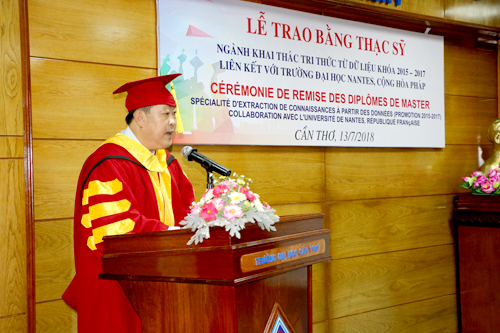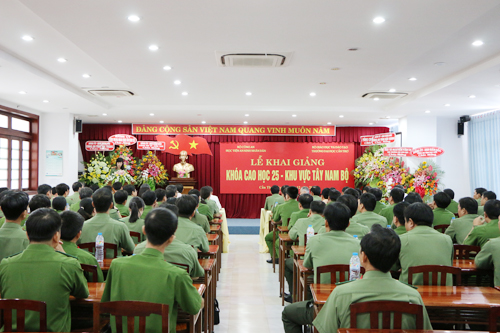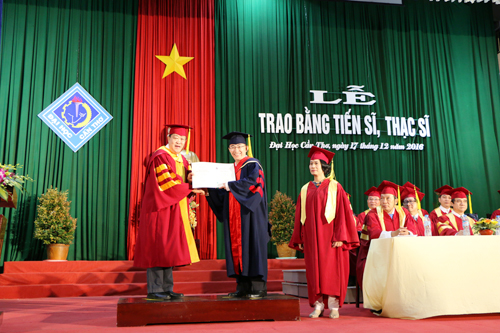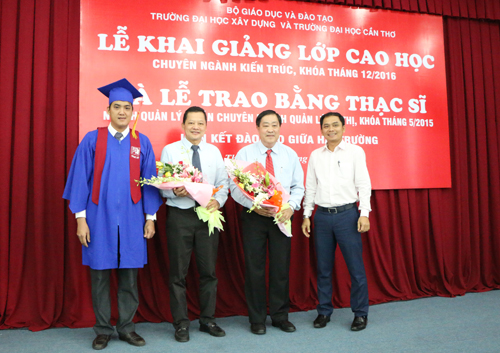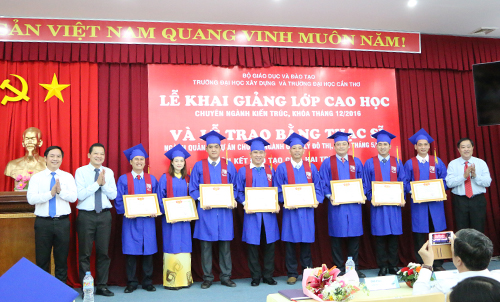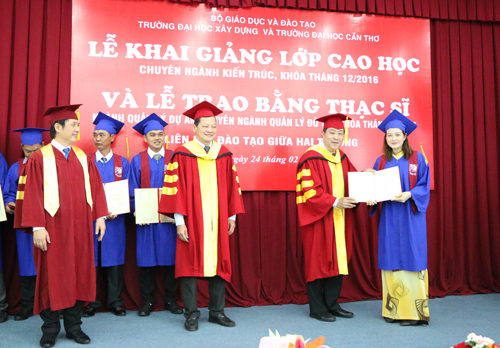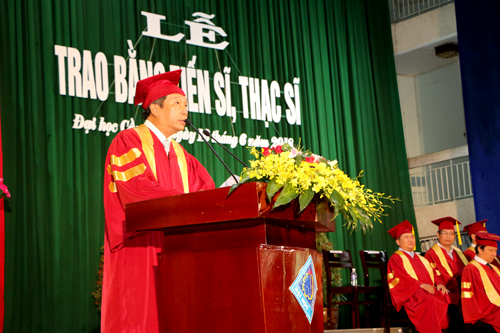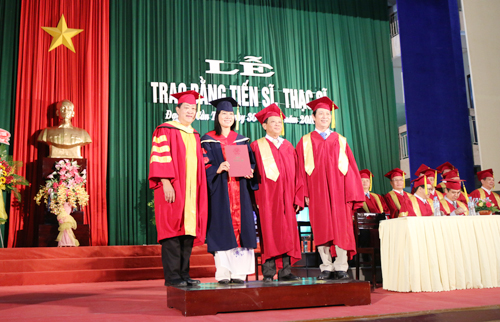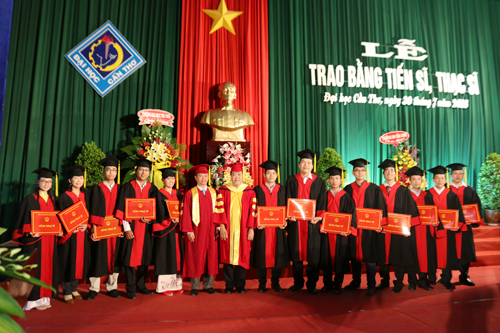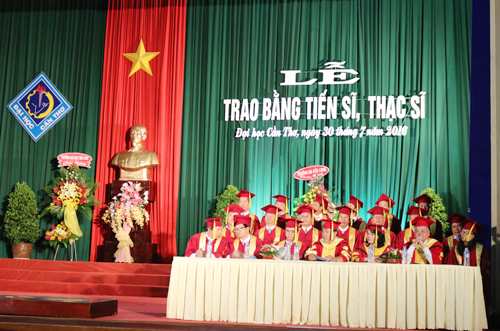
Tên đề tài: “Khả năng hấp phụ dinh dưỡng và giảm phát thải khí nhà kính của than trấu và than lục bình”.
Tác giả: Nguyễn Đạt Phương, Khóa: 2017
Chuyên ngành: Môi trường đất và nước ; Mã số: 62440303. Nhóm ngành: Khoa học tự nhiên.
Người hướng dẫn chính: PGS.TS. Nguyễn Xuân Lộc - Trường Đại học Cần Thơ.
Người hướng dẫn chính: PGS.TS. Ngô Thụy Diễm Trang - Trường Đại học Cần Thơ.
- Tóm tắt nội dung luận án
Luận án được thực hiện nhằm chế tạo than trấu và than lục bình; ứng dụng than sinh học hấp phụ chất ô nhiễm từ nước thải biogas; và sử dụng than sinh học như chất mang và cung cấp dinh dưỡng cho cây rau muống, giảm phát thải khí nhà kính trong trồng lúa. Than trấu và than lục bình được nhiệt phân ở 500°C, 700°C và 900°C. Các thí nghiệm được bố trí để xác khả năng hấp phụ ammonium, nitrate; thí nghiệm sinh trưởng của cây rau muống khi bổ sung than trấu hoặc than lục bình đã hấp phụ dinh dưỡng; và thí nghiệm xác định khả năng giảm phát thải CH4 và N2O. Than trấu và than lục bình được sản xuất ở nhiệt độ nhiệt phân 700°C đều hấp phụ ammonium (NH4+) và nitrate (NO3−) trong nước thải biogas. Sự hấp phụ NH4+ và NO3− của 2 loại than này phù hợp với mô hình động học biểu kiến bậc 1 và bậc 2; mô hình Langmuir phù hợp hơn mô hình Freundlich. Dung lượng hấp phụ NH4+ và NO3− lớn nhất theo mô hình Langmuir của than trấu và than lục bình lần lượt là 5,51 mg g−1 và 4,31 mg g−1; 9,87 mg g−1 và 9,59 mg g−1 đạt hiệu suất 24,71% và 26,71%; 69,70% và 64,14%. Than trấu và than lục bình hấp phụ NH4+ hoặc NO3− của nước thải biogas làm tăng chiều cao, số lá, chiều dài rễ, trọng lượng tươi, trọng lượng khô và sinh khối của cây rau muống. Than trấu và than lục bình hấp phụ NH4+ hoặc NO3− kết hợp với phân bón vô cơ ở tỷ lệ 50 : 50 cho sinh khối rau muống cao nhất. Bổ sung than trấu hoặc than lục bình vào đất trồng lúa làm giảm phát thải khí nhà kính. Hiệu quả giảm phát thải CH4 và N2O của nghiệm thức bổ sung 20 tấn ha−1 cao hơn so với các nghiệm thức bổ sung 5 tấn ha−1 và 10 tấn ha−1 lần lượt là 15,99%, 48,47% cho than trấu và 20,14%, 51,90% cho than lục bình. Than sinh trấu và lục bình có thể được sử dụng làm nguyên liệu hấp phụ dinh dưỡng biogas. Than sau hấp phụ có thể bón đất làm tăng năng suất cây trồng, giảm ô nhiễm môi trường và giảm phát thải khí nhà kính góp phần hạn chế tác động của biến đổi khí hậu (BĐKH) toàn cầu.
- Những kết quả mới của luận án
Than trấu và than lục bình ở 700oC đều có khả năng hấp phụ NH4+ và NO3− trong nước thải biogas. Dung lượng hấp phụ NH4+ và NO3− lớn nhất của than trấu và than lục bình lần lượt là 5,51 mg g−1 và 4,31 mg g−1; 9,87 mg g−1 và 9,59 mg g−1 (hiệu suất 24,71% và 26,71%; 69,70% và 64,14%).
Than trấu và than lục bình ở 700oC hấp phụ NH4+ hoặc NO3− của nước thải biogas đều có ảnh hưởng tốt cho sự phát triển về sinh khối của cây rau muống. Kết hợp phân bón hóa học với than trấu hoặc than lục bình ở tỷ lệ 50 : 50 cho sinh khối tốt nhất.
Bổ sung 20 tấn ha−1 than trấu hoặc than lục bình vào đất nông nghiệp có ảnh hưởng đến việc giảm phát thải khí CH4 và N2O cao nhất lần lượt là 15,99%, 48,47% cho than trấu và 20,14%, 51,90% cho than lục bình.
Than sinh học sản xuất từ nguyên liệu rẻ tiền ở địa phương là trấu, một phụ phẩm ngành sản xuất lúa và cây lục bình, một loại cây có thể gặp ở nhiều nơi ở Việt Nam làm nguyên liệu hấp phụ dinh dưỡng.
Sử dụng vật liệu hấp phụ làm chất mang dinh dưỡng cho cây trồng, với 2 tác dụng, chuyển chất ô nhiễm từ nước thải sinh học (biogas) thành chất dinh dưỡng và sử dụng than sinh học như một tác nhân mang và cung cấp dinh dưỡng cho cây trồng.
Làm giảm ô nhiễm môi trường và giảm phát thải khí nhà kính từ canh tác cây trồng, giúp tăng cường lợi ích kinh tế và lợi ích môi trường cho người dân trong khu vực và góp phần hạn chế tác động của BĐKH toàn cầu.
- Các ứng dụng/khả năng ứng dụng trong thực tiễn, các vấn đề cần tiếp tục nghiên cứu
Than sinh học được sản xuất từ trấu và lục bình có thể được sử dụng làm vật liệu hấp phụ dinh dưỡng (NH4+ và NO3−) trong nước thải chăn nuôi, hạn chế gây ô nhiễm môi trường. Than sinh học sau khi hấp phụ dưỡng chất có thể được sử dụng để bón cho đất canh tác lúa và góp phần cải thiện sinh khối của cây rau muống. Mặt khác, than sinh học bón cho đất còn có khả năng giảm thiểu sự phát thải khí nhà kính (CH4 và N2O) trong sản xuất nông nghiệp ở đồng bằng sông Cửu Long. Kết quả của nghiên cứu còn có thể được sử dụng làm tài liệu phục vụ cho công tác giảng dạy và nghiên cứu tại các viện, trường đại học.
Cần nghiên cứu ứng dụng than trấu và than lục bình hấp phụ NH4+ hoặc NO3− trồng cây rau muống ra ngoài đồng để ứng dụng vào thực tiễn sản xuất.
Thesis title: “Ability to adsorb nutrients and reduce greenhouse gas emissions from rice husk biochar and water hyacinth biochar”
Specialization: Land and Water Environment; Code: 62440303
Full name of PhD student: Nguyen Dat Phuong; Course: 2017 - 2021
Full name of scientific supervisor: Assoc. Prof. Dr. Nguyen Xuan Loc
Full name of sub-instructor: Assoc. Prof. Dr. Ngo Thuy Diem Trang
Training facilities: Can Tho University
- Content of thesis summary
The thesis was carried out to make rice husk biochar (RHB) and water hyacinth biochar (WHB); application of biochar to adsorb pollutants from biogas wastewater; and use biochar as a carrier and provide nutrients for water spinach, reducing greenhouse gas emissions in rice cultivation. Rice husk biochar and WHB were pyrolyzed at 500°C, 700°C, and 900°C. Experiments were conducted to determine the adsorption capacity of ammonium and nitrate; growth experiment of water spinach with supplementing rice husk or hyacinth biochar absorbed nutrients; and experiments to determine the ability to reduce CH4 and N2O emissions. The RHB and WHB prepared at the pyrolysis temperature of 700°C had the ability to adsorb both ammonium (NH4+) and nitrate (NO3−) in biogas wastewater. NH4+ and NO3− adsorption of two biochars was fitted with a first-order kinetic model and a second-order kinetic model. These two biochars' NH4+ and NO3− adsorption were more consistent with the Langmuir model than the Freundlich model. The largest NH4+ and NO3− adsorption capacity, according to the Langmuir model of the RHB and WHB, was 5.51 mg g−1 and 4.31 mg g−1; 9.87 mg g−1 and 9.59 mg g−1 with achieved efficiency 24.71% and 26.71%; 69.7% and 64.14%, respectively. Rice husk biochar and WHB adsorbed ammonium or nitrate in biogas wastewater, which increased the growth in terms of height, number of leaves, root length, fresh weight, dry weight, and biomass of water spinach. Rice husk biochar and hyacinth biochar adsorbed ammonium or nitrate combined with inorganic chemical fertilizers at the ratio of 50:50 resulted in the highest biomass of water spinach. Rice husk biochar or WHB amendment to paddy rice reduced greenhouse gas (GHG) emissions. The effectiveness of reducing CH4 and N2O emissions of the treatment adding 20 tons ha−1 was higher than of the treatments adding 5 tons ha−1 and 10 tons ha−1 by 15.99%, 48.47% of RHB and 20,14%, 51,9% for WHB, respectively. Rice husk biochar and WHB can be used as materials for nutrient adsorption in biogas wastewater. Post-adsorbed biochar can fertilize the soil to increase crop yields, reduce environmental pollution and reduce GHG emissions, contributing to limiting the impact of global climate change.
- The new aspects of the thesis
Rice husk biochar and WHB produced at 700oC are capable of adsorbing NH4+ and NO3− in biogas wastewater. The highest adsorption capacity of NH4+ and NO3− of RHB and WHB was 5.51 mg g−1 and 4.31 mg g−1, respectively; 9.87 mg g−1 and 9.59 mg g−1, respectively (efficiency 24.71% and 26.71%; 69.70% and 64.14%).
Rice husk biochar and WHB at 700oC adsorb NH4+ or NO3− of biogas wastewater, which have a good effect on the growth of biomass of the water spinach. Combining chemical fertilizers and RHB or WHB with a ratio of 50:50 are the best biomass.
Adding 20 tons ha−1 of RHB or WHB to agricultural land had the highest effect on reducing CH4 and N2O emissions by 15.99%, 48.47%, of RHB and 20,14%, 51,90% for WHB, respectively.
Biochar is produced from cheap local materials such as rice husk, a by-product of rice production, and water hyacinth, a plant that can be found in many parts of Vietnam as a nutrient absorbent.
Using adsorbent as a nutrient carrier for plants, with 2 effects, converting pollutants from biological wastewater (biogas) into nutrients, using biochar as a carrier, and supplying nutrition for plants.
Reduces environmental pollution and reduces GHG emissions from crop farming, which enhances economic and environmental benefits for people in the region and contributes to limiting the impact of global climate change.
- Application prospects and suggestions for further study
Biochar produced from rice husk and water hyacinth can be used as a nutrient adsorbent (NH4+ and NO3−) in livestock wastewater, limiting environmental pollution. Biochar, after absorbing nutrients, can be used to fertilize rice cultivation land and improve the biomass of water spinach. On the other hand, biochar fertilizer to land has the ability to reduce greenhouse gas emissions (CH4 and N2O) in agricultural production in the Mekong Delta. The research results can also be used as documents for teaching and research at institutes and universities.
It is necessary to study the application of RHB and WHB to absorb NH4+ or NO3− to plant the water spinach in the field for practical application.
- Xem chi tiết nội dung luận án
- Xem thông tin đăng tải tại Website Bộ giáo dục và Đào tạo. (Nhập tên NCS vào ô tìm kiếm)





